As the complexity of peptides continues to grow, so does the use of amino acids with side chain protecting groups that can be selectively removed, leaving the peptide on resin and the remaining side chain protecting groups intact. While there are protocols to be found in the literature, they may not work to the highest level of efficiency every single time. This can lead to disasterous results for any subsequent chemistry.
In today’s post, I’ll evaluate a variety of conditions for removing an ivDde protecting group from the lysine side chain amine.
The use of orthogonal side chain protecting group has increased in frequency, as a tool for introducing additional complexity or chemistries during solid phase peptide synthesis for one reason or another. I’ve had the opportunity to synthesize peptides using these building blocks on several occasions. And it never fails, something goes awry and the general protocol that I found in the literature just doesn’t work for me.
Whether it’s the absence of a particular additive or the type of mixing I utilize, my initial results were almost always low yielding. So, before I undertake my complex peptide synthesis, I decided to optimize removing an ivDde group from a generic peptide. This will (hopefully) save in precious amino acid waste as well as reduce the overall synthesis time requirements.
For this optimization I started with a general protocol and decided to work a bit with each of the possible parameters: hydrazine concentration, reaction time, solution volume, and finally, reaction iterations. It was also important for me to conduct these evaluations using my Biotage® Initiator+ Alstra™ as the oscillating mixing mechanism may yield different results than mixing with a standard stir bar.
So to get started, I made a huge batch of peptide, my favorite fragment of ACP with a Lys(ivDde) on the C-terminus. It’s much easier to optimize a deprotection strategy when all your crude peptides are equivalent. I really didn’t want to take the time or risk the synthesis-to-synthesis variability that could influence the outcome of this evaluation. As expected, the synthesis proceeded quite nicely, Figure 1.
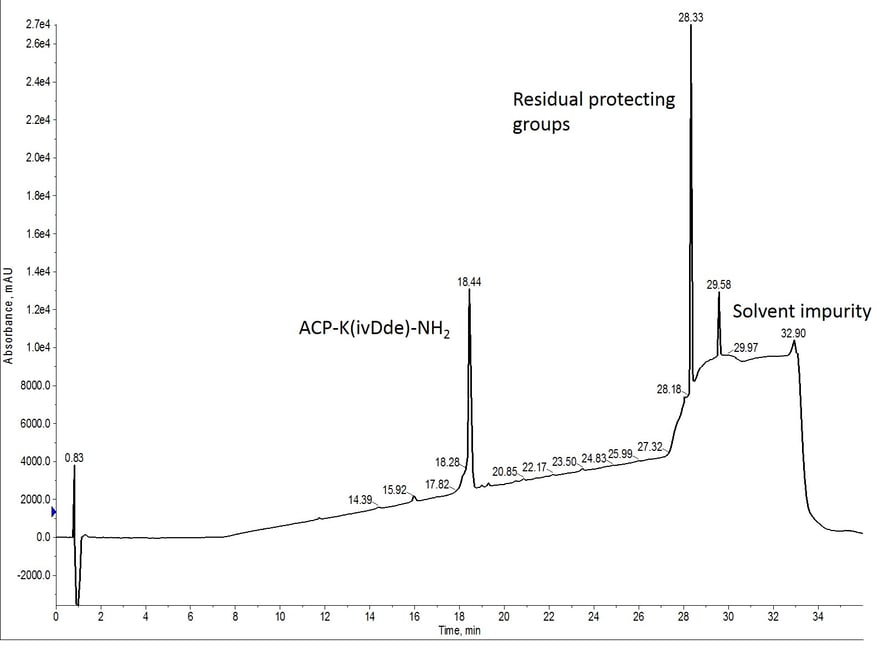
Figure 1: Analytical HPLC of crude ACP-K(ivDde) confirming successful synthesis and incorporation of ivDde protected Lys.
With the peptide on hand, I divided roughly equivalent quantities of peptidyl resin into each of 12 new reactor vials. To each of these reactor vials I would evaluate the ivDde deprotection conditions listed below, Table 1. Using the above described strategy, I was able to evaluate 12 conditions in a few hours, rather than waiting for 12 full syntheses to complete.
| condition | hydrazine concentration (% volume) | reaction time (min) | volume added to reactor vial (mL) | reaction iterations |
| 1 | 2 | 3 | 1.5 | 3 |
| 2 | 2 | 3 | 2 | 3 |
| 3 | 2 | 3 | 3 | 3 |
| 4 | 2 | 2 | 2 | 3 |
| 5 | 2 | 4 | 2 | 3 |
| 6 | 2 | 5 | 2 | 3 |
| 7 | 2 | 3 | 2 | 1 |
| 8 | 2 | 3 | 2 | 2 |
| 9 | 2 | 3 | 2 | 4 |
| 10 | 1 | 3 | 2 | 3 |
| 11 | 3 | 3 | 2 | 3 |
| 12 | 4 | 3 | 2 | 3 |
Table 1. Summary of conditions evaluated for ivDDe protecting group removal.
I don’t want to bore you with sheets and sheets of chromatograms, so I’ll chose a few standouts from the bunch to discuss qualitatively.
First, let’s take a look at condition 2, which essentially represents the conditions I found during my literature search. As I sort of expected from previous selected side chain protecting group removals, this condition yielded incomplete ivDde removal, Figure 2.
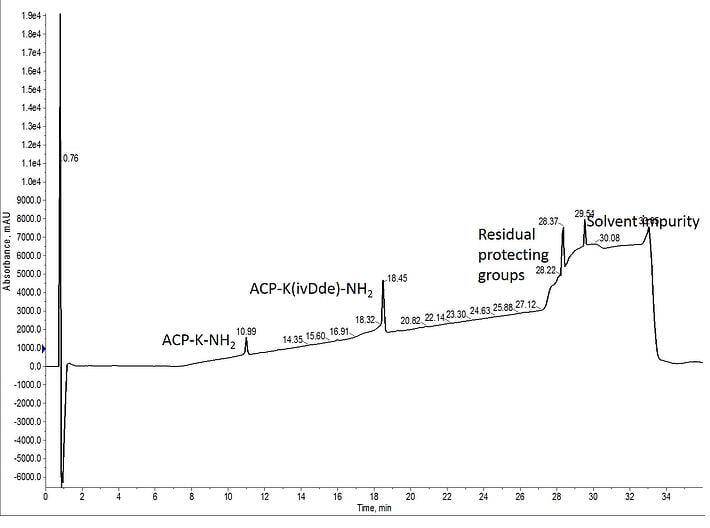
Figure 2: Analytical HPLC of crude ACP-K peptide treated with 2 mL of 2% hydrazine for 3 minutes for each of 3 repititions. Only a small fraction of the ivDde is removed under these conditions.
For condition #6, the reaction time was increased to five minutes. Although this isn’t a significant time increase, it is almost double the initial reaction time evaluated. Keeping all the other factors equal, increasing the reaction time only allowed for a marginal increase in deprotection completion, Figure 3.
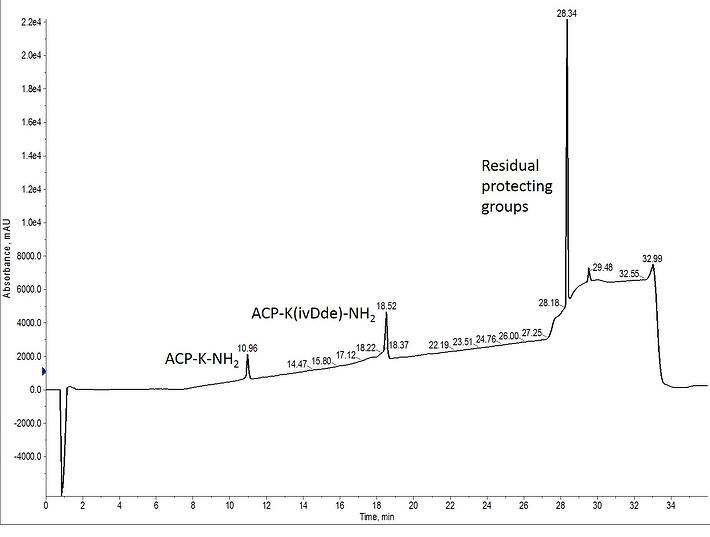
Figure 3: Analytical HPLC of crude ACP-K peptide treated with 2 mL of 2% hydrazine for 5 min in each of 3 repititions. The peak area for each peptide peaks are highly similar, suggesting ivDde removal is only ~50% complete.
The same results were observed when the number of reaction iterations was increased. Within this small optimization panel, increasing the number of iterations from 3 to 4 (condition 10) only permitted nominal increases in deprotection completion, Figure 4.
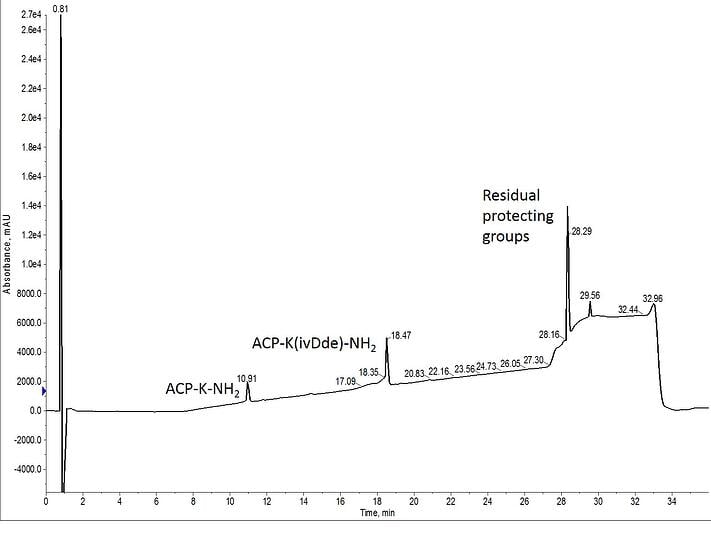
Figure 4: Analytical HPLC of crude ACP-K treated with 2 mL of 2% hydrazine for 3 min in each of 4 repititions. As seen above, the peak areas are also approximately equivelent suggesting that only ~50% of the ivDde is actually removed.
For this series of conditions, the most significant differences were observed when the concentration of hydrazine increased. Increasing the hydrazine concentration to 4% allowed for nearly complete ivDde removal in condition 12, Figure 5. Now before you all jump into the lab and put these conditions to practice, ensure that your instrument is still mechanically compatible with the greater quanitites of hydrazine. I did increase the number of washes both in the reactor vial as well as for the liquid handler to ensure mechanical safety of my Initiator+ Alstra™.
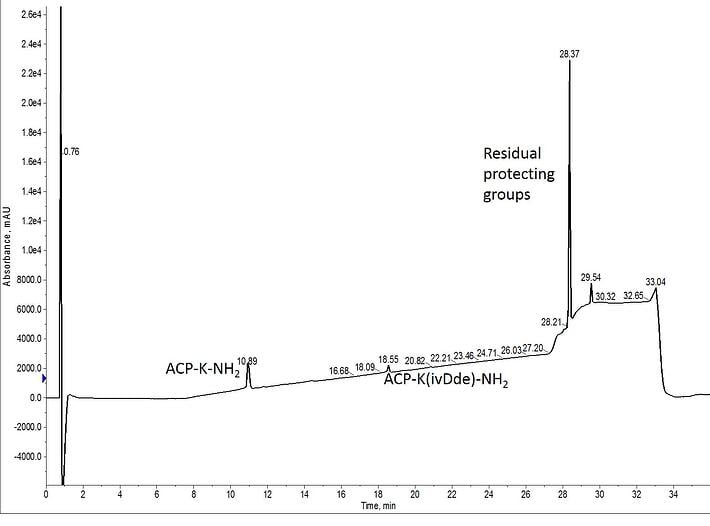
Figure 5: Analytical HPLC of crude ACP-K treated with 2 mL of 4% hydrazine for 3 min in each of 3 repititions. The peak area for the deprotected peptide is is significantly larger than the area for ivDde protected peptide, suggesting near complete ivDde removal.
I certainly could have evaluated many more conditions, and most of you out there may still chose to optimize these conditions further. It will be important to consider the mixing mechanism used to stir this reaction when applying these results to your work. I certainly expect that a different set of conditions will be required for alternative mixing mechanisms. But in the future, I will be removing my ivDde protecting group with 4% hydrazine in DMF, requiring only 3 reaction iterations lasting 3 minutes each.
Want to learn how to reduce your time spent performing peptide materials preparation - synthesizing peptides for use in real experiments?

